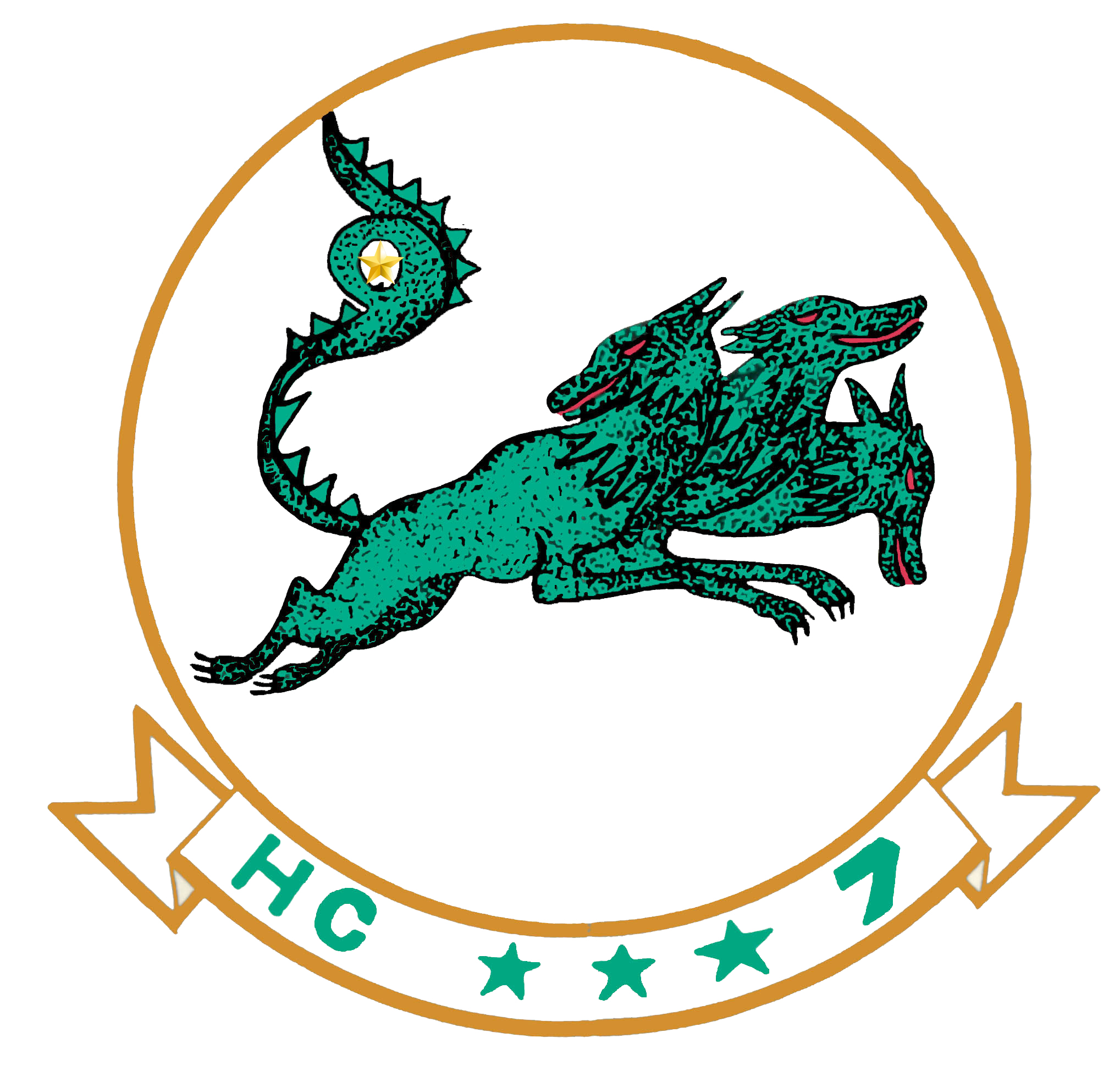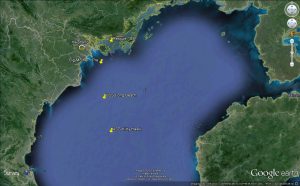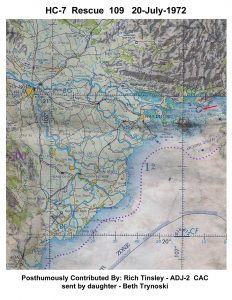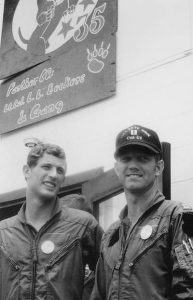
HC-7 RESCUE 109(1) 20-Jul-1972 (Thursday)
HH-3A Sikorsky Seaking helo Det 110 Big Mother #60
USS Biddle (CG-11) Combat Day (2)
2.5 miles off North Vietnam coast – within many islands
Pilot – LT John L. Pitts
Co-pilot – LTJG Ralph W. Fairbanks
1st crew – ADJ-3 Timothy M. McCarthy
2nd crew – ADRAN Elvin C. Milledge
F-4D Phantom 66-0265 “UP” (Scuba-1) 35 TFS,
3 TFW attached to 388 TFW, USAF, Korat, Thailand
Capt Joe Lee Burns
1 Lt Mike Nelson
On the 20th the Air Force flew a Linebacker strike on POL storage at Kep airfield. The strike force hit the target and retired to the south to fly out over the Gulf of Tonkin before climbing to altitude for the return flight to Thailand. As Capt Burns was a few miles north of Hon Gay and about to cross the coast at 5,000 feet, his aircraft was hit by AAA and burst into flames. The aircraft just made it to the sea before the crew were forced to eject. They came down in the water close to the North Vietnamese coast but were rescued by a Navy HH-3 helicopter. Capt Burns was on his second tour in Southeast Asia and had flown 222 combat missions. He later helped set up the T-38 Aggressor Squadron at Nellis AFB to teach air combat training with the benefit of experience from Southeast Asia. He later commanded the 44th TFS. (5)


Statement of LT John L. Pitts – pilot of Big Mother 60
The SAR effort began 20 July at approximately 11:30. Myself LT John PITTS, my copilot LTJG FAIRBANKS and my two crewman, 1st crewmen ADJ2 Tim McCarthy, 2nd crewmen ADRAN, Elvin MILLEDGE, were the crew of BIG MOTHER 60. As briefed, we were stationed at a preposition point for an Air Force strike in the Hai Phong area. We had just arrived on station when we heard over the tactical frequency of the strike aircraft that one of their members was on fire and had bailed out at the coast, “feet wet”. We began preparations and received a radar vector to the area from OSWALD (USS LONG BEACH). At about this time we heard that both survivors were OK and in their rafts waiting for a pickup. COPYRIGHT 11 from HSL-31 was vectored near us to act as a radio link to OSWALD since we were too low to receive any transmissions from OSWALD. We, upon reaching a station near the survivors’ area, were placed in a holding pattern until RESCAP and an OSC could be fueled and ready. At this point in the SAR effort is where the problems began to develop. Our only communications with OSWALD was through COPYRIGHT 11 and so we were second hand to any information that was to be passed. We remained for nearly an hour in orbit waiting for permission to go in. During this hour we could hear various ON SCENE COMMANDERS and RESCAP talking but couldn’t get permission from OSWALD to go in. We called a number of times inquiring about the delay. At about 12:35 we had somewhat less than 11/2 hours of fuel remaining and decided that it would be necessary to go very soon or fuel wouldn’t permit us to make the rescue. We climbed up to 700′ and called “RITA”, the present OSC, to ask for a TACAN fix on his position. We got a fix and an ADF cut on his radio transmitter. With the cut we began to fly as fast as we could to the spot. About 4 or 5 miles from the scene my copilot spotted the aircraft circling the survivor.
The area was a maze of small islands, which was actually in our favor in some respects. The islands protected us because we flew among them and kept us pretty much out of sight except to aircraft above us. When we were within a mile, the OSC spotted us and helped us to the spot. We didn’t see the survivors until we were nearly on top of them because of the density and height of the islands.
When the survivors spotted us they popped a day flare which marked their spot, but also gave the wind direction which was very valuable. We had to fly around an island to make the approach and had to continue to make left turns for our swimmer drop and wave off. We came in dropped our swimmer at 10′ and 10 knots. Then made a circle while the swimmer, ADRAN MILLEDGE prepared the survivors for a pickup. We came back to a hover and hoisted up the pilot and then the RIO and our swimmer. Our largest problem here was holding the hover. The winds were light, it was hot and we were heavy so were at full power on #2 engine and within 3% of topping on #1 engine. Once all were aboard we broke the hover made yet one more pass to sink the raft to prevent confusion later. Once we had sunk the rafts we headed out to the sea again escorted by the OSG and the other F-4’s who had provided our cover. When clear of the harbor’s entrance and all the islands we climbed to 500 feet and got radio communications with OSWALD. About 20 minutes we were on the deck. We landed with about 35-45 minutes of fuel remaining. Both survivors were fine with only some minor cuts and scratches.
In conclusion, I would like to note the professional attitude and manner with which my two crewman responded. They both did an outstanding job, carefully and quickly with very little confusion.
Statement of LTJG Ralph W. Fairbanks – co-pilot of Big Mother 60
On the 20th of July, I was copilot BIG MOTHER 60 which at that time was stationed on South SAR aboard the USS BIDDLE. We departed the ship at 10:50 (11:03 launch helicopter SH3-60. 11:04 secure helo detail. (13) ) on a preposition for an Air Force strike north of the HAI PRONG HARBOR area. We went under control of OSWALD, the USS LONG BEACH and had a backup, an HSL-31 helicopter, COPYRIGHT 11. She acted as communications link as we were at 300′ and too low for reception. Our preposition point was 107 degrees E 20 degrees 30 feet N, about 10 miles off the coast. Shortly after arriving there, we heard on #2 radio, tuned into Air Force strike that SCUBA 1 was down and the survivors were in rafts, holding hands and in good condition. I changed #2 radio to GUARD frequency to get a DF cut on them if possible. The next hour was a complete flail. We had no communications with OSWALD and could not receive permission from HARBORMASTER via COPYRIGHT 11 to go in and get them. We were making a tracking of 060 and 240 degrees up and down the coast. There were several A-7’s and F-4’s in the area but we still could not get authorization. Finally, with one and a half (hour) fuel remaining we decided to go pick them up, as we were getting no response from OSWALD. Several F-4’s had circled us and a few seconds later were over the survivors so we knew they were not far away. They were receiving some flak at this time An Air Force F-4, “RITA” was circling the area so I switched #2 radio to ADF. We got a steer of 310 degrees. We were entering the mouth of HAI PHONG HARBOR. This area, geographically described, contained, numerous rock islands jutting out of the water covered with dense ground foliage. This topography was ideal for us as we could skirt in between the rocks and thus were relatively safe from ground fire. As we were weaving our way into the pickup zone, I spotted two F-4s circling the area. One of the aircraft spotted us when we were about one mile away and aided in steering us in. It was difficult trying to find the men in the raft due to the terrain. Finally at about our ONE o’clock I spotted them in their rafts about 100’ out away from one of the rock islands. The entire time I was looking for any ground fire from the nearby rocks but
never saw any. As I approached the survivor, one of them popped an orange smoke. This was very valuable as at our preposition area the surface wind was from 200 at 15 mph. However, the smoke showed it to be from about 300 degrees. The OAT was about 32 degrees centigrade so the correct wind direction was crucial. We had burned down to about I hours fuel by this time. We made an upwind pass and dropped the swimmer at 10’ and 10 knots. We had to break left due to a high rock being on the pilot’s immediate right. We circled another rock to my left and came to a hover over the survivors and swimmer. The engines were at or near topping. The pilot was hoisted up first and then the copilot and swimmer together. We broke hover once they were safely inside and then made a pass over the rafts again and shot them up with the mini-gun to sink them and avoid confusion at a later time as to a possible man in the water. We returned without further incident to the USS LONG BEACH accompanied by a couple camouflaged Air Force F-4′ s in slow flight. Approximate time of pickup was 12:50 and return to the ship was 13:25. I believe the area of pickup was about 107 degrees 15 feet (minutes) E and 20 degrees 50 feet (minutes) N.
Statement of ADJ2 Timothy M. McCarthy – 1st crewman of Big Mother 60
We were on a preposition when we got a beeper ,then the report of two chutes. We were ready and in position in about two minutes, but didn’t go in for about an hour after that. RESCAP was so confused and wouldn’t give us any vectors nor permission to go in. Finally, after we told them that we only had a few minutes remaining before we’d be too low on fuel to start a rescue. They gave us permission and we started in.
LTJG FAIRBANKS saw RESCAP and we headed for them, saw the two survivors, who gave us a smoke. We made an up wind approach dropped ADRAN MILLEDGE from 5′ about 10 knots. I got a thumbs up and did a race track to the left, MILLEDGE was ready picked up one survivor, then MILLEDGE and the second survivor.
The hover was great and there were no problems, I don’t have any suggestion for further rescues except that RESCAP was not coordinated in their efforts.
Statement of ADRAN Elvin C. Milledge – 2nd crewman of Big Mother 60
On July 20th, at 10:50 BIG MOTHER 60 lifted off the deck of the USS Biddle (CG-34)
for a routine preposition in the area of the harbor of HAI PHONG for an Air Force strike.
The 1st crewman, Tim McCARTHY and I performed our security check proceeded to rig for SAR. • As second crewman my position was forward. I rigged the M-60 and placed M-16s within reach of the pilots. • After just arriving on station, we heard over the radio that an F-4 was hit by AAA and on fire. The crippled aircraft was directed to go feet wet. • At this time, I removed my normal flight gear and donned my swim gear. I returned to I.C.S. to wait for further instructions and to continue to perform my duties as second crewman. • We were vectored to a different area closer to the survivors who were reported as being in rafts, close together in good conditions. • After circling this area for nearly an hour, we started to get low on fuel and we hadn’t received permission from HARBORMASTER to go in and get the survivors. • At about 12:35 we climbed to 700′ and established communications with “RITA!” the OSC. After receiving information on his position, we then took a heading for his position. The F-4’s were than spotted by LT John PITTS and LTJG Ralph FAIRBANKS our pilots. Shortly afterwards they spotted the survivors by a small island and also their day flare. I then left I.C.S. and moved to the cargo door. We then made our approach and at 10’ and 10 knots I was given the signal to leave the aircraft. I gave the first crewman a thumbs up and proceeded directly to the survivors. I asked them how they felt and they answered “OK”. They were together and about 20 feet from their rafts. After a quick check to make sure they were OK and clear of their chutes we swam away from the island and the rafts. I then splashed the water to signal BIG MOTHER that I was ready for the first survivor. After hooking the 1st survivor up I gave a thumbs up and he started up. After he was clear of the water I swam to the 2nd survivor and made ready for the second pick up. The BIG MOTHER then came forward about 30 feet and after hooking both the survivor and myself up I signaled the lst crewman and we came out of the water. We came up alongside the aircraft and then into the aircraft with no problem. Once inside the helo we set the survivors forward and helped them remove their flotation gear. I came up on I.C.S. and reported that the survivors and I were in good condition. We were still among the islands so I returned to the M-60. Once clear of the islands and safely at sea we stowed all weapons and loose gear.
Since, the survivors were not injured and very calm the pickup was made quickly and safely.
Lt-Rt- LT Mike Nelson, Capt Joe Lee Burns
(contributed by: Joe Lee Burns, USAF Col. Retired)
1) Numbering as per HC-7 Rescue Log (accumulative rescue number)
2) HC-7 Rescue Log
3) HC-7 Det 110 Rescue report – No first page
4) Map – Google Earth
5) “Vietnam – Air Losses” By: Chris Hobson (with permission)
6) Loss aircraft location data provided by: W. Howard Plunkett (LtCol USAF, retired)
10) HC-7 History collection; Ron Milam – Historian
12) USS Long Beach and USS Kitty Hawk – Deck Logs – NO data
13) USS Biddle (DLG-34) – Deck Log
OSC – On Scene Commander
(Compiled / written by: Ron Milam, HC-7 Historian – HC-7, 2-1969 to 7-1970, Det 108 & 113)
